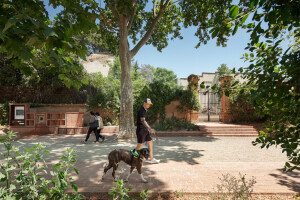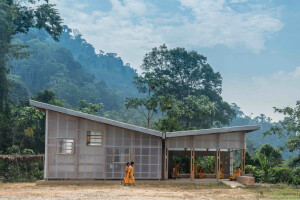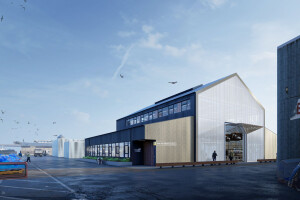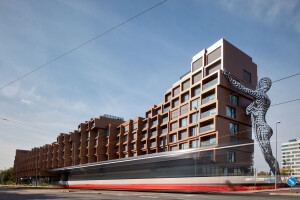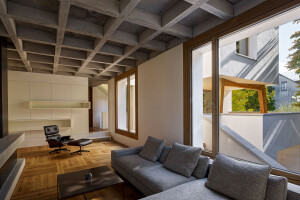The Frida Kahlo Museum, also known as the Blue House for the structure's cobalt-blue walls, is a historic house museum and art museum dedicated to the life and work of Mexican artist Frida Kahlo. It is located in the Colonia del Carmen neighborhood of Coyoacán in Mexico City. The building was the birthplace of Kahlo and is also the home where she grew up, lived with her husband Diego Rivera for a number of years, and eventually died, in one of the rooms on the upper floor. In 1958, Diego Rivera donated the home and its contents in order to turn it into a museum in Frida's honor.
The museum contains a collection of artwork by Frida Kahlo, Diego Rivera and other artists along with the couple’s Mexican folk art, pre-Hispanic artifacts, photographs, memorabilia, personal items, and more. The collection is displayed in the rooms of the house, which remains much as it was in the 1950s. Today, it is the most popular museum in Coyoacán and one of the most visited in Mexico City.
Originally the house was the family home of Frida Kahlo, but since 1958, it has served as a museum dedicated to her life and work. With about 25,000 visitors monthly, it is one of Mexico City’s most-visited museums, and the most-visited site in Coyoacán. It is supported solely by ticket sales and donations. The museum demonstrates the lifestyle of wealthy Mexican bohemian artists and intellectuals during the first half of the 20th century. The entrance ticket to the Casa Azul allows for free entrance into the nearbyAnahuacalli Museum, which was also established by Diego Rivera. According to records and testimony, the house today looks much as it did in 1951, decorated with Mexican folk art, Kahlo’s personal art collection, a large collection of pre-Hispanic artifacts, traditional Mexican cookware, linens, personal mementos such as photographs, postcards and letters, and works by José María Velasco, Paul Klee and Diego Rivera. Much of the collection is now in display cases designed for their preservation. The museum also contains a café and a small gift shop.
The museum consists of ten rooms. On the ground floor is a room that contains some of Kahlo’s mostly minor works such as "Frida y la cesárea", 1907–1954, "Retrato de familia", 1934, "Ruina 1947", "Retrato de Guillermo Kahlo", 1952 y "El marxismodarásalud", 1954 (showing Frida throwing away her crutches), with a watercolor “Diario de Frida” in the center. This room originally was the formal living room, where Frida and Diego entertained notable Mexican and international visitors and friends such as Sergei Eisenstein, Nelson Rockefeller, George Gershwin, caricaturist Miguel Covarrubias and actresses Dolores del Río and .MaríaFélix.
The second and third rooms are dedicated to personal effects and mementos and to some of Rivera’s works respectively. The second room is filled with everyday items Frida used, letters, photographs and notes. On the walls are pre-Hispanic necklaces and folk dresses, especially the Tehuana-style ones that were Frida’s trademark. Paintings in the third room include "Retrato de Carmen Portes Gil", 1921, "Ofrenda del día de muertos", 1943, and "Mujer con cuerpo de guitarra", 1916.
The fourth room contains contemporary paintings by artists such as Paul Klee, José María Velasco, JoaquínClausel, Celia Calderón Orozco, and a sculpture by MardonioMagaña. The fifth room contains two large Judas figures, “mujeres bonitos” figures from Tlatilco, State of Mexico and figures from the Teotihuacan culture. The large papier-mâché Judas figures and other paper mache monsters were traditionally filled with firecrackers and exploded on the Saturday before Easter.
The sixth and seventh rooms are the kitchen and dining room. Both are in classic Mexican style, with bright yellow tile and the floor, blue and yellow tile counters and a long yellow table, where sister Ruth stated that Frida spent much of her time. The two rooms are filled with large earthenware pots, plates, utensils, glassware and more which came from Metepec, Oaxaca, Tlaquepaque and Guanajuato, all known for their handcrafted items. Decorative features include papier-mache Judas skeletons hanging from its ceiling, and walls with tiny pots spelling the names of Frida and Diego next to a pair of doves tying a lovers’ knot.
Off the dining room was Rivera’s bedroom, with his hat, jacket and work clothes still hanging from a wall rack. Next to this is a stairwell that leads from the courtyard area to the upper floor. This area also contains a large number of folk art items includes about 2000 votive paintings from the colonial period to the 20th centuries, other colonial era work and more Judas figures.
The two rooms of the upper floor which are open to the public contain Frida’s final bedroom and studio area. This is located in the wing that Rivera had built. The original furniture is still there. In one corner, her ashes are on display in an urn, which is surrounded by a funeral mask, some personal items and mirrors on the ceiling. On her bed is a painted plaster corset she was forced to wear to support her damaged spine, and under the canopy is a mirror facing down which she used to paint her many self-portraits. The head of the bed contains the painting of a dead child, and the foot contains photo montage of Joseph Stalin, Vladimir Lenin, Karl Marx, Friedrich Engels and Mao Zedong. The pillow is embroidered with the words "Do not forget me, my love." Her wheelchair is drawn up to an unfinished portrait of Stalin, on an easel which is said was given to her by Nelson Rockefeller. Stalin became a hero to Kahlo after she and Rivera had a falling out with Trotsky.
The tour of the museum ends at the large courtyard garden which is completely enclosed by the four sides or wings of the structure. The courtyard area is divided by a stepped pyramid, a fountain and a reflection pool. These were built in the 1940s when Rivera first moved into the house and built the fourth wing enclosing the house. This wing’s walls which face the courtyard are decorated with marine shells and mirrors. There are also sculptures by Mexican artist MardonioMagaña. One side of the courtyard is the following inscription "Frida y Diego / vivieron en / esta casa / 1929-1954" (Frida and Diego lived in this house – 1929-1954).






















